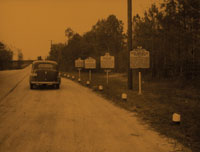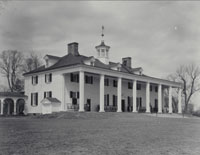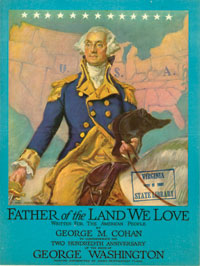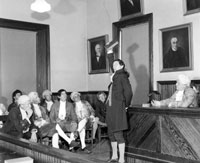Landscape of Memory

The interpretation of history leaves its mark on both communal memory and the physical landscape. Have you ever read a historical highway marker or followed a heritage trail? Have you wondered why a street in your town was named after a person? Virginia’s communities provide ordered, tangible representations of the past through activities such as naming streets and buildings after historical figures and events and holding dedication ceremonies for monuments and historical markers.
Preservation of the past through historic structures is hardly unique to Virginia. Nevertheless, Virginia was home to two of the earliest organizations—the Mount Vernon Ladies’ Association and the Association for the Preservation of Virginia Antiquities—that sought to preserve physical remains of the commonwealth’s past. Both organizations were founded before 1900 by women who, denied open access to politics and many public venues, embraced preservation as part of their responsibilities as nurturers. Preserving historic places, they reasoned, enabled them to educate and inoculate the next generation with the virtues of past Virginians. The Virginia landscape is filled with historic house museums that connect visitors to local events or dignitaries of the past. The National Park Service, established in 1916, includes historic properties within its system, including the Petersburg National Military Park (1926) and the George Washington Birthplace Monument (1930) at Wakefield. In an ironic pairing, the Richmond National Battlefield Park, which memorializes the Civil War, administers the Maggie Walker House, former home of Maggie Lena Walker, the first African American woman bank president in the United States.

George Washington occupies a special place in Virginia and American history. A native Virginian, he became a revered leader during his lifetime and took on almost mythic status at his death in 1799. As the leader of the Continental Army, he accepted the surrender of British troops at Yorktown, ending the American Revolution. Washington was elected the first president of the United States and served two terms before retiring to his home, Mount Vernon. Ann Pamela Cunningham founded the Mount Vernon Ladies’ Association in 1853 to preserve the property. And in 1932 every state in the U.S. celebrated the bicentennial of George Washington’s birth. That same year the federal George Washington Bicentennial Commission initiated the building of the George Washington Memorial Parkway, directed a tree-planting campaign, and encouraged a wide variety of educational activities. As the United States entered the Great Depression, Washington was held up as the ideal American who expressed strength in the face of adversity. The bicentennial events also served to define what was “American” and to teach American values to immigrants.

Pageants celebrating historical events and outdoor dramas based on local history offer unique expressions of collective memory. The celebration of the 1876 Centennial of the American Revolution sparked years of historical celebrations and national expositions that cheerfully emphasized both the growing industrial strength of the country and the American values of patriotism, hard work, and religious belief. The emphasis on Anglo-American culture excluded the contributions of American Indians, African Americans, and other ethnic groups to American history. Before the 1940s historical pageants were big business, requiring costume manufacturers, theatrical directors, and administrators, such as the John B. Rogers Producing Co., of Fostoria, Ohio. As the Richmond News Leader noted in January 1921, “a pageant can be of genuine educational as well as of definite advertising value.” These pageants involved local residents in public tableaux, speeches, fireworks, and parades. Outdoor dramas mixed local citizens with professional actors and served to encourage tourism in localities. Begun in 1964, The Trail of the Lonesome Pine, based on the novel by John H. Fox Jr., and staged annually in Big Stone Gap in Wise County, is the longest-running outdoor drama in Virginia. Williamsburg hosted two Paul Green outdoor dramas—The Common Glory and The Founders—from the 1930s until the 1970s.
